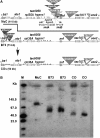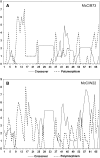Maize genome structure variation: interplay between retrotransposon polymorphisms and genic recombination
- PMID: 18296625
- PMCID: PMC2276454
- DOI: 10.1105/tpc.107.057596
Maize genome structure variation: interplay between retrotransposon polymorphisms and genic recombination
Abstract
Although maize (Zea mays) retrotransposons are recombinationally inert, the highly polymorphic structure of maize haplotypes raises questions regarding the local effect of intergenic retrotransposons on recombination. To examine this effect, we compared recombination in the same genetic interval with and without a large retrotransposon cluster. We used three different bz1 locus haplotypes, McC, B73, and W22, in the same genetic background. We analyzed recombination between the bz1 and stc1 markers in heterozygotes that differ by the presence and absence of a 26-kb intergenic retrotransposon cluster. To facilitate the genetic screen, we used Ds and Ac markers that allowed us to identify recombinants by their seed pigmentation. We sequenced 239 recombination junctions and assigned them to a single nucleotide polymorphism-delimited interval in the region. The genetic distance between the markers was twofold smaller in the presence of the retrotransposon cluster. The reduction was seen in bz1 and stc1, but no recombination occurred in the highly polymorphic intergenic region of either heterozygote. Recombination within genes shuffled flanking retrotransposon clusters, creating new chimeric haplotypes and either contracting or expanding the physical distance between markers. Our findings imply that haplotype structure will profoundly affect the correlation between genetic and physical distance for the same interval in maize.
Figures





Comment in
-
Retrotransposon polymorphisms affect genic recombination in maize.Plant Cell. 2008 Feb;20(2):247. doi: 10.1105/tpc.108.200213. Epub 2008 Feb 26. Plant Cell. 2008. PMID: 18314497 Free PMC article. No abstract available.
References
-
- Baker, W.S. (1958). Crossing over in heterochromatin. Am. Nat. 92 59–60.
-
- Beavis, W.D., and Grant, D. (1991). A linkage map based on information from four F2 populations of maize (Zea mays L.). Theor. Appl. Genet. 82 636–644. - PubMed
Publication types
MeSH terms
Substances
Associated data
- Actions
LinkOut - more resources
Full Text Sources

